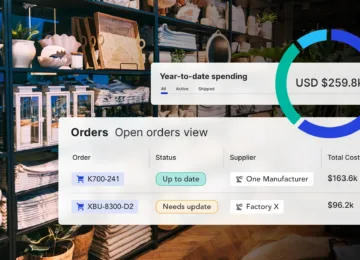Logistics is an important part of running your company successfully. Whether you handle them in-house or outsource a third-party logistics company, ensuring your products are stored, packaged, transported, and delivered successfully is a huge part of increasing profitability and customer satisfaction. A strong logistics process and logistics management plan gives you a competitive advantage and eliminates inefficiencies in your operations.
However, creating a winning logistics strategy is easier said than done. Knowing how to create an effective logistics strategy requires a strong understanding of logistics and supply chain factors. This article will help you understand how you can streamline your logistics operations and create a great strategic plan.
What Is a Logistics Strategy?
A logistics strategy is a set of principles, goals, and initiatives that help to coordinate logistics planning between different players in a supply chain. A logistics strategy helps refine the sourcing, obtaining, storing, finding, packaging, and transporting of goods to customers. It helps to refine the service levels of your organization and create a cost-effective and efficient approach to logistics.
Put simply, a logistics strategy helps businesses know how to deliver the right products to the right customers at the right time — and for the lowest possible cost.
Logistics Strategy vs. Logistics Planning
As we go forward, it’s important to note that there is a difference between logistics strategy and logistics planning. Planning tends to focus on immediate, short-term goals, while a strategy focuses on bigger-picture items and long-term goals.
For example, logistics planning might consider the best way to move a specific product about and increase logistics visibility for the transportation. A logistics strategy examines the entire logistics process and determines if there are areas that need improvement, or if your team needs to create a new process to optimize profitability.
How Do You Develop a Logistics Strategy?
After some challenging years for logistics and major disruptions to the supply chain, many companies are considering re-evaluating their current logistics strategies and considering new approaches to supply chain management. To get started, however, you need to know what steps to take to develop your logistics strategy correctly.
Ask the Right Questions
One of the best ways to start developing your logistics strategy is to ask yourself questions and brainstorm the best solutions as you go forward. You can even make this a team activity, which helps increase cooperation and bring more ideas into the fold. Some questions you might want to consider include:
- How does deciding strategic supply chain initiatives help improve wider business strategies?
- What is the best number of warehouses, distribution centers, and fulfillment centers to ensure that operations can run smoothly?
- How closely can products be manufactured to distributors and warehouses?
- Have you optimized every function in your logistics process?
- Do you have a process in place for communicating new policies, information, and procedures throughout your system?
- Does your logistics strategy require a change in the current management plan?
- How well is your current transportation strategy helping service levels?
- Would partnering with a third-party logistics company help you improve the current service levels?
- Do you currently harvest enough data from your logistics systems, or are new systems with better dashboards, KPIs, and metrics required?
- Do your competitors offer better services?
- How can your logistics strategy help to improve customer service and customer satisfaction?
- Do you utilize real-time data, or do you still rely on old or inaccurate data that could lead to errors in your logistics systems?
- Is your logistics strategy in line with your company’s business objectives and overarching strategies?
Understand the 4 Levels of Logistics
The next step of your process is to break down the four levels of logistics. These levels are a great starting point for your planning, and while the intricacies of logistics strategies go much deeper, these four levels can help to jump start your process and get you thinking in the right direction.
Strategic
The first level is strategic thinking. The strategic elements of supply chain management include activities like reviewing how your entire logistics organization contributes to your business’s high-level objectives, and examining the value that your current logistics add to your organization’s profitability and growth.
Structural
The next step is to examine the structure of your current logistics processes. You need to closely pick apart any structural issues that you might have, like not having enough warehouses or distribution centers. Other structural issues include limited access to raw materials, or products being produced at a plant far away from the fulfillment center instead of one closer to the center of activities.
Functional
The next level of a logistics strategy is to review the separate functions in the logistics organization. By examining each individual function and its value, you can learn more about what changes are necessary to achieve functional excellence.
Implementation
The final stage of the logistics strategy is the implementation level. By examining your implementation plan, you can see what strategic changes can help to improve your logistics and how you can roll out those changes.
Incorporate the Key Elements of Logistics Strategy
The next step of creating your logistics strategy includes zooming out to better understand logistics basics. This can help businesses identify inefficiencies and propose solutions to improve the entire process.
Storage, Warehousing, and Material Handling
The first key element of incorporation is the storing, warehousing, and handling of materials. To operate at peak efficiency, manufacturers must have more goods on hand than consumers demand. To store surpluses, you need warehousing and material handling strategies.
Packaging and Unitization
The packing and unitization is another key element of a logistics strategy. This role is essential for moving products from one place to another and helps products of all different shapes and sizes come together for transport.
Inventory
Inventory is another important factor in logistics related to warehousing and storage. Inventory is the control of the flow of goods in and out of a warehouse, and includes keeping track of stock levels, locations, and predicting when items will be required (or will need to be reordered).
Transport
Transport is a logistics factor that refers to the actual movement of goods out of a warehouse and to the consumer or end user. It includes modes of transport like freight trains, road vehicles, cargo shipping, and even air transport.
Information and Control
The last element of a logistics strategy is information and control. This refers to the data that helps you learn how to manage your supply chain and control the operational procedures in your warehouses and fulfillment centers.
Establish Long-Term Goals and Create a Plan
A logistics strategy needs to focus on long-term goals. A long-term goal is a goal that usually takes place over more than a year out, has long-lasting implications, and ties into other areas of your business. It’s important that you have a list of considerations going into your planning, including:
- An overview of the logistics strategy
- Objectives for each area of the logistics strategy that explains how they relate to the product and the customer
- Strategic descriptions for each part of the plan, including inventory and warehousing, transportation, order fulfillment and processing, and customer service goals
- Breakdowns of the steps within the logistics plan and operational plan, including timing, implementation costs, technology costs, and business function impacts
- Forecasts for the costs needed for working capital, cash flow, and overhead
- Financial statements for capital requirements
- Business analysis for the impacts that the plan will have on profits, customer service, and other key business functions
The Benefits of Being Strategic With Logistics
There are many benefits to having a logistics strategy and coming into your planning with a strategic mindset. Logistics strategies help you improve your supply chain process and increase your organization’s profitability. It also helps you set yourself up for success when it’s time to scale and grow your organization. Other benefits include:
- Increased efficiencies in your processes
- Lower operational costs
- Higher production rates
- Better inventory control and management
- Warehouse space optimization (and consequently, better warehouse management)
- Better customer and supply satisfaction levels
- Improved customer experience
25 Tips To Improve Your Logistics Strategy
Now that you know the general process you need to take to put together a logistics strategy successfully, let’s take a closer look at some individual tips and tricks you can use in your strategy creation process. These will allow you to improve the quality of your logistics strategy and plan for the future with more accuracy.
- Collaborate with the team: Collaboration is an important part of the planning process, as it helps ensure everyone has a voice with your strategy and multiple voices are heard.
- Center around your supply chain: The supply chain is the cornerstone of your logistics planning, so you need to be able to take a big picture look at your supply chain before you get started.
- Include steps for environmental sustainability: Environmental sustainability is important to consider in your plans. Think about what steps you can take to limit your negative impact on the environment.
- The supply chain affects all areas of the business: The supply chain doesn’t just affect your logistics — it impacts all areas of your business, including other departments and long-term business goals.
- Understand that a new strategy might mean risk: There are always risks when implementing a new strategy, especially when it’s drastically different from old ways of doing business.
- Prepare for the worst-case scenario: Always have a contingency plan or emergency plan in place for the worst-case scenario, so you know your next steps in case of a major problem.
- Use historical data to make informed decisions: Past data about your supply chain can help you with your decision-making processes and help you learn more about your current processes.
- Refocus on inventory management: Inefficient inventory management systems can have a snowball effect on the rest of your business. Re-evaluating these areas can help you improve your overall efficiency.
- Examine your 3pl provider: Creating a strategy is a great time to examine your third-party logistics provider. Is it time to move on and find a new service provider, or are you still set for the next few years?
- Promote supply chain visibility: Promoting your supply chain’s visibility is important, as it shows providers and suppliers that you have the tools to track your products in the supply chain.
- Examine your pick and pack processes: The process of picking goods off the shelves and getting them to their destination can also be an area of your strategy that needs improvement.
- Make your strategy scalable: A strategy won’t last long in your organization if there is no room for scalability. Make sure there is room for growth in your processes.
- Consider the customer experience: Your customer experience is a major factor in your business’s success. By focusing on the experience, you can create a better process overall.
- Be clear about your returns policy: Making it hard for customers to return products can damage your organization’s reputation with customers.
- Take a look at your product pages: Another way to improve the customer experience is to ensure your product pages and descriptions are accurate and helpful.
- Take advantage of automated systems: Automated systems are more accurate, relevant, and helpful than manual systems that take time and slow down processes.
- Use a logistics management software platform: Having the right technology can ensure that your processes are up to date and running as efficiently as possible.
- Think 10 years ahead: A logistics strategy should be forward-thinking, so ask yourself if it will work 10 or more years in the future.
- Automate repetitive tasks: If repetitive tasks are slowing down your workforce and processes, think about what steps you can take to automate those tasks.
- Use integrated shipping carriers: Integrated shippers help your warehouse print labels, create manifests, and automate alerts for shipping milestones.
- Improve your scheduling process: Your employees are a huge part of your fulfillment center’s success. Making sure their scheduling process is optimized can improve morale.
- Listen to your employees: Take note of what your employees say, particularly if they notice a common problem in the system that you could improve.
- Add value to your team: Find ways to add value for your team with activities like ongoing education and free training.
- Set attainable goals: Ensure your strategy’s goals are attainable and reasonable, so your whole team is dedicated to meeting them.
- Stay current on customer experience trends: Note what your competitors are doing and the new customer experience trends.
Anvyl Makes It Easy To Develop, Maintain, and Track Your Logistics Strategy
A logistics strategy is essential to your company’s success, whether you have a small business or are part of a large operations management conglomerate. Optimizing your logistics requires understanding the methodology behind supply chain operations, corporate strategy, and logistics costs. When you know how to create a logistics service that helps you track your logistics systems and deliver goods to customers accurately, you can see all the benefits of your hard work.
At Anvyl, we want to make it easy for you to develop, maintain, and track your logistics strategies. See how our incredible logistics visibility can streamline your operations today.



